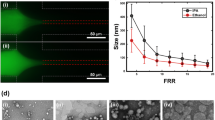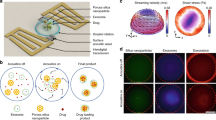Abstract
The mass transport characteristics of cationic, nonviral liposome–DNA plasmid complexes (lipoplexes) were evaluated over a range of fluid shear stresses. The typical case of stagnant flow transfection was expanded to include controlled fluid convection provided by constant flow through a parallel plate flow chamber. Equations describing the transport of lipoplex by sedimentation and convection were derived from theory and solved numerically. Instantaneous lipoplex delivery rate and total lipoplex surface delivery during a 72-h transfection were estimated for two shear stress levels and for static conditions. Theory predicted that lipoplex is delivered to the cell surface more than 12- to 19-fold faster through the addition of convection, at least for physiologic shear stresses of 2.3–9.7 dyn/cm2, respectively. These calculations were tested experimentally using a cell line (ECV-304) transfected with fluorescently labeled plasmid DNA formulated into a lipoplex. Transfections were conducted during cellular exposure to the same known, uniform levels of fluid shear stress presumed in theoretical calculations. Lipoplex delivery was increased by more than nine-fold at 2.3 dyn/cm2 compared to the static case as assessed by flow cytometric measurement. Lipoplex delivery was modestly reduced at the highest fluid shear stress, to six-fold of the static case, consistent with the disruption of lipoplex–cell binding mediated by hydrodynamic forces. The complicated relationship between fluid convection and lipoplex delivery has important implications for nonviral gene therapy.
This is a preview of subscription content, access via your institution
Access options
Subscribe to this journal
Receive 12 print issues and online access
$259.00 per year
only $21.58 per issue
Buy this article
- Purchase on Springer Link
- Instant access to full article PDF
Prices may be subject to local taxes which are calculated during checkout





Similar content being viewed by others
References
Brenner H . The slow motion of a sphere through a viscous fluid towards a plane surface. Chem Eng Sci 1961; 16: 242–251.
Goldman AJ, Cox RJ, Brenner H . Slow viscous motion of a sphere parallel to a plane wall – I. Motion through a quiescent fluid. Chem Eng Sci 1967; 22: 637–651.
Goldman AJ, Cox RJ, Brenner H . Slow viscous motion of a sphere parallel to a plane wall – II. Couette flow. Chem Eng Sci 1967; 22: 653–660.
Bike SG, Lazarro L, Prieve DC . Electrokinetic lift of a sphere moving in slow shear flow parallel to a wall. J Colloid Interf Sci 1995; 175: 411–421.
Kim D, Beissinger RL . Augmented mass transport of macromolecules in sheared suspensions to surfaces. J Colloid Interf Sci 1993; 159: 9–20.
Kim D, Cha W, Beissinger RL . Mass transport of macromolecules in solution to surfaces. J Colloid Interf Sci 1993; 159: 1–8.
Danov K, Aust R, Durst F, Lange U . Influence of the surface viscosity on the hydrodynamic resistance and surface diffusivity of a large Brownian particle. J Colloid Interf Sci 1995; 175: 36–45.
Reynolds AM . A Lagrangian stochastic model for the dispersion and deposition of Brownian particles. J Colloid Interf Sci 1999; 217: 348–356.
Mohandas N, Hochmuch RM, Spaeth EE . Adhesion of red cells to foreign surfaces in the presence of flow. J Biomed Mater Res 1974; 8: 119–136.
Kowalczynska HM, Nowak M, Dowjat WK, Doroszewski J . Adhesion and locomotion of L5222 cells on endothelium, collagen, and glass. J Cell Sci 1982; 55: 317–325.
Doroszewski J, Golab-Meyer Z, Guryn W . Adhesion of cells in flowing suspensions: effects of shearing force and cell kinetic energy. Microvas Res 1979; 18: 421–433.
Doroszewski J . Short-term and incomplete cell–substrate adhesion. In: ASG Curtis JP (ed). Cell Adhesion and Motility. Cambridge University Press: London, 1980, pp 171–184.
Wattenbarger MR, Graves DJ, Lauffenburger DA . Specific adhesion of glycophorin liposomes to a lectin surface in shear flow. Biophys J 1990; 57: 765–777.
Frangos JA, McIntire LV, Eskin SG . Shear stress induced stimulation of mammalian cell metabolism. Biotech Bioeng 1987; 32: 1053–1060.
Zhang Z, Xiao Z, Diamond SL . Shear stress induction of C-type natriuretic peptide (CNP) in endothelial cells is independent of NO autocrine signaling. Ann Biomed Eng 1999; 27: 419–426.
Nauman EA, Risic KJ, Keaveny TM, Satcher RL . Quantitative assessment of steady and pulsatile flow fields in a parallel plate flow chamber. Ann Biomed Eng 1999; 27: 194–199.
Cha WR . Augmented mass transport of macromolecules in sheared suspensions to surfaces. J Colloid Interf Sci 1996; 178: 1–9.
Houston P, White BP, Campbell CJ, Braddock M . Delivery and expression of fluid shear-stress-inducible promoters to the vessel wall: applications for cardiovascular gene therapy. Hum Gene Ther 1999; 10: 3031–3044.
Doroudi R, Gan LM, Selin S, Jern S . Effects of shear stress on eicosanoid gene expression and metabolite production in vascular endothelium as studied in a novel biomechanical perfusion model. Biochem Biophys Res Commun 2000; 269: 257–264.
Palsson B, Andreadis S . The physio-chemical factors that govern retrovirus-mediated gene transfer. Exp Hematol 1997; 25: 94–102.
Chuck A, Palsson B . Consistent and high rates of gene transfer can be obtained using flow-through transduction over a wide range of retroviral titers. Gene Therapy 1996; 7: 743–750.
Chuck AS, Clarke MF, Palsson BO . Retroviral infection is limited by Brownian motion. Hum Gene Ther 1996; 7: 1527–1534.
Bahnson AB et al. Centrifugal enhancement of retroviral mediated gene transfer. J Virol Methods 1995; 54: 131–143.
Bunnell BA et al. High-efficiency retroviral-mediated gene transfer into human and nonhuman primate peripheral blood lymphocytes. Proc Natl Acad Sci USA 1995; 92: 7739–7743.
Kotani H et al. Improved methods of retroviral vector transduction and production for gene therapy. Hum Gene Ther 1994; 5: 19–28.
Rejman J, Oberle V, Zuhorn IS, Hoekstra D . Size-dependent internalization of particles via the pathways of clathrin- and caveolae-mediated endocytosis. Biochem J 2004; 377: 159–169.
Tseng WC, Haselton FR, Giorgio TD . Transfection by cationic liposomes using simultaneous single cell measurements of plasmid delivery and transgene expression. J Biol Chem 1997; 272: 25641–25647.
Tseng WC, Haselton FR, Giorgio TD . Mitosis enhances transgene expression of plasmid delivered by cationic liposomes. Biochim Biophys Acta 1999; 1445: 53–64.
Miller CR et al. Liposome–cell interactions in vitro: effect of liposome surface charge on the binding and endocytosis of conventional and sterically stabilized liposomes. Biochemistry 1998; 37: 12875–12883.
Xu Y, Hui SW, Frederik P, Szoka Jr FC . Physicochemical characterization and purification of cationic lipoplexes. Biophys J 1999; 77: 341–353.
Tseng W, Purvis NB, Haselton FR, Giorgio TD . Cationic liposomal delivery of plasmid to endothelial cells measured by quantitative flow cytometry. Biotech Bioeng 1996; 50: 548–554.
James MB, Giorgio TD . Nuclear-associated plasmid, but not cell-associated plasmid, is correlated with transgene expression in cultured mammalian cells. Mol Ther 2000; 1: 339–346.
Wyatt SK, Giorgio TD . DNA delivery to cells in culture using cationic liposomes. Methods Mol Biol 2004; 245: 83–94.
da Cruz MT et al. Kinetic analysis of the initial steps involved in lipoplex–cell interactions: effect of various factors that influence transfection activity. Biochim Biophys Acta 2001; 1510: 136–151.
Acknowledgements
We thank Amanda Buxton for her contributions to the experimental work and writing and to the Intracellular Engineering Laboratory at Vanderbilt University for assistance. The Division of Bioengineering and Environmental Systems of the National Science Foundation under award BES-9902697 supported this work.
Author information
Authors and Affiliations
Rights and permissions
About this article
Cite this article
Harris, S., Giorgio, T. Convective flow increases lipoplex delivery rate to in vitro cellular monolayers. Gene Ther 12, 512–520 (2005). https://doi.org/10.1038/sj.gt.3302397
Received:
Accepted:
Published:
Issue Date:
DOI: https://doi.org/10.1038/sj.gt.3302397
Keywords
This article is cited by
-
Non-viral gene delivery to human mesenchymal stem cells: a practical guide towards cell engineering
Journal of Biological Engineering (2023)
-
Vibropolyfection: coupling polymer-mediated gene delivery to mechanical stimulation to enhance transfection of adherent cells
Journal of Nanobiotechnology (2022)
-
Biomimetic shear stress and nanoparticulate drug delivery
Journal of Pharmaceutical Investigation (2017)
-
Shear stress increases cytotoxicity and reduces transfection efficiency of liposomal gene delivery to CHO-S cells
Cytotechnology (2016)
-
Microfluidic System for Facilitated Quantification of Nanoparticle Accumulation to Cells Under Laminar Flow
Annals of Biomedical Engineering (2013)



